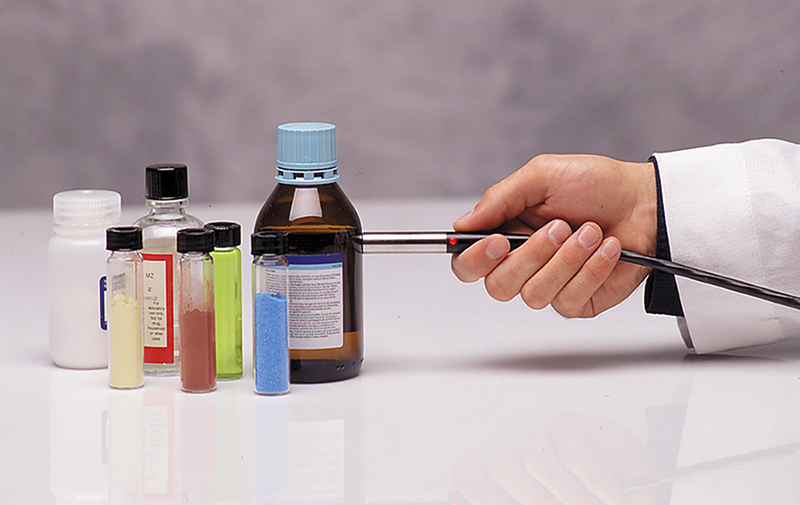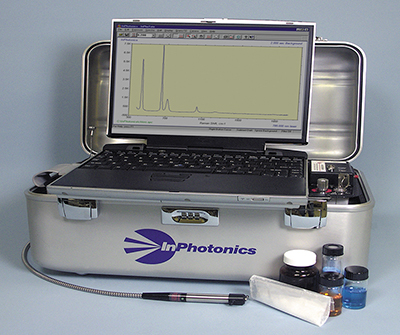
Approaching Suspicious Substances Safely
Originating Technology/ NASA Contribution
A mineral identification tool that was developed for NASA’s Mars Rover Technology Development program is now serving as a powerful tool for U.S. law enforcement agencies and military personnel to identify suspicious liquid and solid substances.
Partnership
In 1998, NASA’s Jet Propulsion Laboratory awarded a Small Business Innovation Research (SBIR) contract to EIC Laboratories, Inc., to develop a portable Raman spectrometer and fiber-optic probe that could be used on a Mars exploration rover. Raman spectroscopy, an analytical technique for identifying molecules in gases, liquids, and solids, uses a laser to scatter light from a targeted sample. The Raman spectrometer detects the returned light in order to identify the sample’s makeup. NASA needed this tool to be easily integrated into a Mars rover to provide chemical identification of Mars soil and mineral samples. Spectrometers such as this one are part of a cluster of instruments in the rover that combine traditional field tools with the equipment typically found in geological laboratories.
EIC Laboratories’ work on the NASA project resulted in a portable Raman spectrometer with dual wavelength illumination that could obtain full-range spectra of mineral samples. The company also developed instrument control software for the system and a database of the Raman spectra of minerals for Mars exploration. The entire spectrometer fits inside a “suitcase” roughly 24 by 16 by 8 inches, and employs a fiber-optic probe 4 by 0.5 inches in diameter that can be integrated into the rover arm.
Product Outcome
The U.S. Army had been using EIC Laboratories’ high-resolution Raman spectrometer for applications such as identifying chemical agents in sealed glass vials, and was interested in buying a man-portable version of it for use in field analysis. At the same time, the U.S. Federal Bureau of Investigation (FBI) began stting up mobile laboratories to ascertain potential threats at high-profile events such as the Democratic National Convention in 2000 and the Presidential Inauguration in 2001. Just like the Army, the FBI needed a portable Raman system with high sensitivity and sufficient spectral resolution to identify unknown chemical substances with confidence.
In response to this need, the basic spectrometer originally built for NASA was repackaged for forensic and military applications. The commercial product, the InPhotote,™ is manufactured and distributed by InPhotonics, Inc. , a spinoff company of EIC Laboratories, co-located in Norwood, Massachusetts. The portable InPhotote is a complete Raman spectrometer system contained in a 16- by 9- by 8-inch aluminum case, weighs approximately 22 pounds, and can be set up in a matter of minutes.
The tool can measure unknown substances through glass and plastic packaging materials with the RamanProbe™ focused fiber-optic probe. The probe length can be extended up to 200 meters to enable users to analyze potentially dangerous substances at a safe distance. In many cases, the spectrometer and personnel are kept in a safe zone while the probe is positioned next to the sample being analyzed. Being able to identify chemicals in remote locations also saves users time and labor, since otherwise the samples would need to be collected, transported, and prepared prior to measurement in the laboratory.
One of the major advantages of Raman spectroscopy over other analysis techniques is its ability to measure through clear and semi-clear containers. Other techniques cannot analyze samples without manipulating or contacting them in some way. Raman spectroscopy, which is very specific to molecular structure, can also be used to identify a wide variety of organic and inorganic compounds as long as there are intramolecular bonds present. InPhotonics is working on expanding its Raman database, which currently contains 243 compounds of explosives and precursors, to include pesticides and other toxic chemicals. According to the company, many of the InPhotote’s users have created their own libraries specific to their application in order to rapidly identify unknown substances in the field.
InPhotonics has seen an increased demand for the InPhotote following the terrorist attacks against the United States on September 11, 2001. Since the system can rapidly identify a wide range of potentially hazardous materials, it is currently of interest to law enforcement and security agencies worldwide. The InPhotote continues to undergo engineering changes to improve detection limits, reduce size and weight, and minimize power consumption for long-term operation off an internal battery.
While the ability to rapidly identify chemicals onsite is more important than ever before, the company is also exploring non-forensic applications. Chemical and pharmaceutical manufacturing facilities would like to bring the laboratory to the sample, rather than transfer a sample to the laboratory and wait for the results. A portable instrument could also be used for quality control of incoming materials or finished products. The latter can be measured through packaging materials as a final step before shipment.
In response to other market needs, InPhotonics recently repackaged the portable system into a laboratory spectrometer known as the VERAX.™ This product meets the needs of customers who want the performance specifications of the InPhotote product but do not require the portable package. The company is targeting the VERAX for process development in the pharmaceutical industry as well as for general analytical and research applications.
InPhotote,™ RamanProbe,™ and VERAX™ are trademarks of InPhotonics, Inc.

The portable InPhotote™ stems from technology developed for the chemical identification of Mars soil and mineral samples.

The InPhotote™ can measure unknown substances through glass and plastic packaging materials with the RamanProbe™ focused fiber-optic probe.













